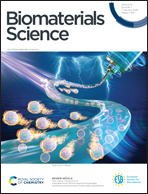Microwave-assisted synthesis of composites based on titanium and hydroxyapatite for dental implantation
Abstract
Titanium (Ti) and its alloys are widely used in clinical practice. As they are not bioactive, hydroxyapatite (HA) is commonly used to modify them. This study offered a review of microwave-assisted synthesis of composites based on Ti and HA for dental implantation by exploring their interaction mechanisms with microwave and features of two main techniques, namely microwave coating and sintering, along with current challenges and potential solutions in the field. It was shown that microwave coating enables rapid deposition of HA, but suffers from problems such as uneven coating thickness, poor integrity and unstable composition of the products. They can be solved by creating interlayers, combining the spin coating technique, etc. Unlike microwave coating, microwave sintering can effectively modify the mechanical properties of the composites, despite the shortcomings of excessive elastic moduli and potential HA decomposition. These issues are expected to be addressed by adding alloying elements and employing appropriate materials as space holders and ion-doped HA for sintering.

- This article is part of the themed collection: Biomaterials Science Recent Review Articles, 2024


 Please wait while we load your content...
Please wait while we load your content...